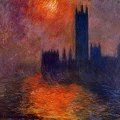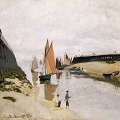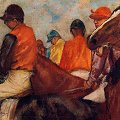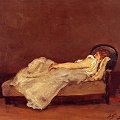Impressionism
 Impressionism, a major movement, first in painting and later in
music, that developed chiefly in France during the late 19th and early
20th centuries. Impressionist painting comprises the work produced
between about 1867 and 1886 by a group of artists who shared a set of
related approaches and techniques. The most conspicuous characteristic
of Impressionism was an attempt to accurately and objectively record
visual reality in terms of transient effects of light and colour.
Impressionism, a major movement, first in painting and later in
music, that developed chiefly in France during the late 19th and early
20th centuries. Impressionist painting comprises the work produced
between about 1867 and 1886 by a group of artists who shared a set of
related approaches and techniques. The most conspicuous characteristic
of Impressionism was an attempt to accurately and objectively record
visual reality in terms of transient effects of light and colour.
Painters
The principal Impressionist painters were Monet, Renoir, Camille Pissarro, Alfred Sisley, Berthe Morisot, Armand Guillaumin, and Frederic Bazille, who worked together, influenced each other, and exhibited together independently. Degas and Cezanne also painted in an Impressionist style for a time in the early 1870s. The established painter Edouard Manet, whose work in the 1860s greatly influenced Monet and others of the group, himself adopted the Impressionist approach about 1873.
These artists became dissatisfied early in their careers with academic teaching's emphasis on depicting a historical or mythological subject matter with literary or anecdotal overtones. They also rejected the conventional imaginative or idealizing treatments of academic painting.
In the late 1860s Monet, Pisarro, Renoir, and others began painting landscapes and river scenes in which they tried to dispassionately record the colours and forms of objects as they appeared in natural light at a given time. These artists abandoned the traditional landscape palette of muted greens, browns, and grays and instead painted in a lighter, sunnier, more brilliant key. They began by painting the play of light upon water and the reflected colours of its ripples, trying to reproduce the manifold and animated effects of sunlight and shadow and of direct and reflected light that they observed. In their efforts to reproduce immediate visual impressions as registered on the retina, they abandoned the use of grays and blacks in shadows as inaccurate and used complementary colours instead.
Play of light and colour
More importantly, they learned to build up objects out of discrete flecks and dabs of pure harmonizing or contrasting colour, thus evoking the broken-hued brilliance and the variations of hue produced by sunlight and its reflections. Forms in their pictures lost their clear outlines and became dematerialized, shimmering and vibrating in a re-creation of actual outdoor conditions. And finally, traditional formal compositions were abandoned in favour of a more casual and less contrived disposition of objects within the picture frame. The Impressionists extended their new techniques to depict landscapes, trees, houses, and even urban street scenes and railroad stations.
 The first
steps toward a systematic Impressionist style were taken in France in
Monet's coast scenes from 1866 onward,
notably the "Terrace" (1866), in which he chose a subject that allowed
use of a full palette of primary colour. The decisive development took
place in 1869, when Monet and Renoir painted together at the resort of
La Grenouillere on the Seine River. The resulting pictures suggest
that Monet contributed the pattern of separate brushstrokes, the light
tonality, and the brilliance of colour; Renoir the overall
iridescence, feathery lightness of touch, and delight in the
recreation of ordinary people. Working at Louveciennes from 1869,
Pissarro evolved the drier and more flexible handling of crumbly paint
that was also to be a common feature of Impressionist painting.
The first
steps toward a systematic Impressionist style were taken in France in
Monet's coast scenes from 1866 onward,
notably the "Terrace" (1866), in which he chose a subject that allowed
use of a full palette of primary colour. The decisive development took
place in 1869, when Monet and Renoir painted together at the resort of
La Grenouillere on the Seine River. The resulting pictures suggest
that Monet contributed the pattern of separate brushstrokes, the light
tonality, and the brilliance of colour; Renoir the overall
iridescence, feathery lightness of touch, and delight in the
recreation of ordinary people. Working at Louveciennes from 1869,
Pissarro evolved the drier and more flexible handling of crumbly paint
that was also to be a common feature of Impressionist painting.
Impression: Sunrise
In 1874 the group held its first show, independent of the official Salon of the French Academy, which had consistently rejected most of their works. Monet's painting "Impression: Sunrise" (1872) earned them the initially derisive name "Impressionists" from the journalist Louis Leroy writing in the satirical magazine Le Charivari in 1874. The artists themselves soon adopted the name as descriptive of their intention to accurately convey visual "impressions." They held seven subsequent shows, the last in 1886. During that time they continued to develop their own personal and individual styles. All, however, affirmed in their work the principles of freedom of technique, a personal rather than a conventional approach to subject matter, and the truthful reproduction of nature.
 A relatively urbane, genrelike trend was detectable in
Degas's picture of Paul Valpincon and his
family at the races called "Carriage at the Races" (1873) and Berthe
Morisot's "The Cradle" (1873). Manet himself was absent, hoping for
academic success; his "Gare Saint-Lazare" (1873), influenced by the
Impressionist palette, was accepted at the Salon. Modeling himself on
Pissarro, Cezanne sublimated the turbulent
emotions of his earlier work in pictures that were studied directly
and closely from nature; he followed the method for the rest of his
life.
A relatively urbane, genrelike trend was detectable in
Degas's picture of Paul Valpincon and his
family at the races called "Carriage at the Races" (1873) and Berthe
Morisot's "The Cradle" (1873). Manet himself was absent, hoping for
academic success; his "Gare Saint-Lazare" (1873), influenced by the
Impressionist palette, was accepted at the Salon. Modeling himself on
Pissarro, Cezanne sublimated the turbulent
emotions of his earlier work in pictures that were studied directly
and closely from nature; he followed the method for the rest of his
life.
The experiment of an independent exhibition was repeated in 1876, though with fewer participants. Monet now began to make studies of the Gare Saint-Lazare. Renoir used effects of dappled light and shadow to explore genre subjects such as "Le Moulin de la galette" (1876). In 1877 only 18 artists exhibited. The major painters began to go their separate ways, particularly as there were disputes about whether to continue with the independent exhibitions. Cezanne, who did not exhibit with the Impressionists again, was perhaps the first to realize that a critical stage had been reached.
For the first time, a style had been based on the openly individual character of a technique rather than on the form of a particular subject or the way it was formulated. A style that admits to painting as being only a matter of paint raises in a peculiarly acute form the question of how far the qualities of art are intrinsic. Impressionism in the 1870s was inseparable from heightened visual experience of a sensuously satisfying world. But the blocklike shapes in Cezanne's pictures, such as the portrait of his patron Victor Chocquet (1877), suggest that for him the relationship between the colour patches on his canvas was equally important. In the years that followed, he systematized his technique into patterns of parallel brushstrokes that gave a new significance to the pictorial surface. An unassuming series of still lifes and self-portraits by Cezanne were painted in 1879-80, and these, when they became known, profoundly impressed the younger generation, who reckoned them to be as monumental as the great art of the past, yet in a subtly different way that was inherent in the actual manner of painting.
A new generation
The style of the 1870s was formless from a traditional standpoint, and at the beginning of the next decade Renoir decided that he had gone to the limit with Impressionism and "did not know either how to paint or draw." Following a trip to Italy, he set about acquiring a wiry, linear style that was the direct opposite of his relaxed, freely brushed manner of earlier years.
 The appearance of a new
generation posed a fresh challenge. Georges Seurat was moving away
from the empirical standpoint of Impressionism toward a technique
(Pointillism) and a form that were increasingly deliberately designed.
Gauguin, taking his starting point from
Cezanne's style of about 1880, passed from a
capricious personal type of Impressionism to a greater use of symbols.
He exhibited with the Impressionists from 1880 onward, but it was soon
evident that group shows could no longer accommodate the growing
diversity.
The appearance of a new
generation posed a fresh challenge. Georges Seurat was moving away
from the empirical standpoint of Impressionism toward a technique
(Pointillism) and a form that were increasingly deliberately designed.
Gauguin, taking his starting point from
Cezanne's style of about 1880, passed from a
capricious personal type of Impressionism to a greater use of symbols.
He exhibited with the Impressionists from 1880 onward, but it was soon
evident that group shows could no longer accommodate the growing
diversity.
In 1884, after the Salon jury had been particularly harsh, the Societe des Artistes Independants was formed. The last Impressionist group show was held in 1886. Only Monet and Armand Guillaumin, to whose efforts the group owed much of its eventual recognition, were now in the strict sense Impressionists. Monet, who had exhibited only once since 1879, continued to build on the original foundation of the style, the rendering of visual impression through colour in paintings that studied a single motif in varying lights. For him the formlessness and the homogeneity of Impressionism were its ultimate virtues. In his last series of "Water Lilies," painted between 1906 and 1926, the shimmering of light eventually lost its last descriptive content, and only the colour and curling movement of his brush carried a general all-pervading reference to the visual world. Renoir's later work was equally expansive; his sympathetic vision of humanity revealed its own inherent breadth and grandeur.
Impressionism, in one aspect, continued the main direction of 19th-century painting, and after 1880 the movement was an international one, taking on independent national characteristics. By the mid-1880s the Impressionist group had begun to dissolve as each painter increasingly pursued his own aesthetic interests and principles. In its short existence, however, it had accomplished a revolution in the history of art, providing a technical starting point for the Postimpressionism artists Cezanne, Degas, Gauguin, Van Gogh, and Georges Seurat and freeing all subsequent Western painting from traditional techniques and approaches to subject matter.
More
Movements
 Art Encyclopedia A world history of art in articles.
Art Encyclopedia A world history of art in articles.
Renaissance
Baroque
Romanticism
Impressionism
Postimpressionism
Modernism
Postmodernism
Art
 Art Wallpapers Art image collections for your desktop.
Art Wallpapers Art image collections for your desktop.
Monet Art, $35
(250 pictures)
Degas Art, $25
(170 pictures)
Renoir Art, $39
(300 pictures)
